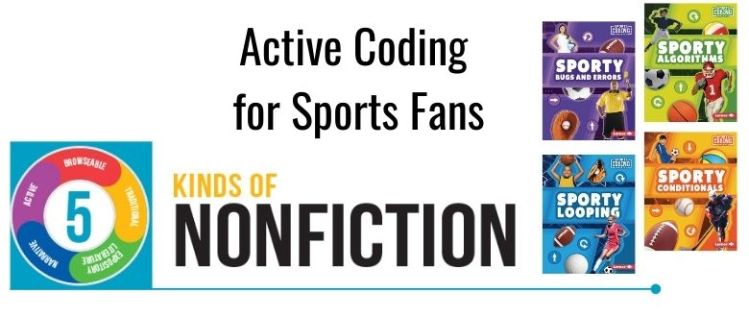Active Coding for Sports Fans

This spring, Lerner Publications launched a new active nonfiction series called Sports Coding Concepts, step-by-step guides for understanding and practicing coding fundamentals such as algorithms, looping, conditionals, and bugs and errors. These are completely unplugged coding titles, meaning readers don’t need a device or a screen of any kind to try out the projects themselves. This screen-free learning is great for parents and educators who are looking to keep their kids busy and active but unplugged (especially during distance learning!). These books are also a great demonstration of active fiction, one of the 5 Kinds of Nonfiction your collection should have.
What does sports have to do with coding? As it turns out, a lot. Because once you learn about coding concepts, you can see them everywhere. A play on the soccer pitch, for example—players passing the ball to one another—is just like an algorithm, or lines of code put together to tell a computer what to do. A repeated part of that play, like passing the ball back and forth, is a loop. Perhaps one player passes the ball only if the other has a clear shot at the goal—that’s a conditional. And if something goes wrong, say the ball is intercepted by the opposing team, that’s a bug in the code!
It’s one thing to just read about coding concepts, however, and another thing to actively engage with them through hands-on projects. The projects in these books are also simple enough that they don’t require materials you don’t likely already have, such as markers and paper.
My favorite projects in Sports Coding Concepts encourage physical movement, and so could double as coding instruction and even a mini physical education lesson. Athletes require exercise and training to stay in peak physical condition for performing in their sport. In Sporty Looping, readers can design a drill that includes a loop, such as 4(Jumping Jack) or Cartwheel, Pushup, 2(Summersault).
In Sporty Conditionals, readers can play the part of a defender with a partner:

Other projects are more thoughtful with less physical activity. In Sporty Bugs and Errors, readers can have a partner try to draw a team mascot (real or imagined). One reader gives another lines of instruction (or code). If the mascot doesn’t turn out right, time to debug the code!

Each activity in Sports Coding Concepts is designed to help readers (and educators!) grasp the fundamentals of coding before making the leap to plugged-in coding such as drag-and-drop coding or, eventually, type coding and using languages. The series was written by Allyssa Loya, a Texas elementary school librarian who has used coding concepts in a coding club at her school. The active nonfiction style helps empower readers gain an understanding of coding through the favorite topic of sports.

Active Nonfiction is a category of Melissa Stewart’s Five Kinds of Nonfiction. This post is part of a weekly series of guest articles by nonfiction authors about their craft, their process, and their amazing books. Stay tuned each week to learn more by visiting the 5 Kinds of Nonfiction page for poster and flyer downloads, curated booklists and more. You can also follow the Lerner Blog’s 5 Kinds of Nonfiction series, or the hashtag #5KNF on Facebook, Twitter, Instagram, and LinkedIn.
Comments